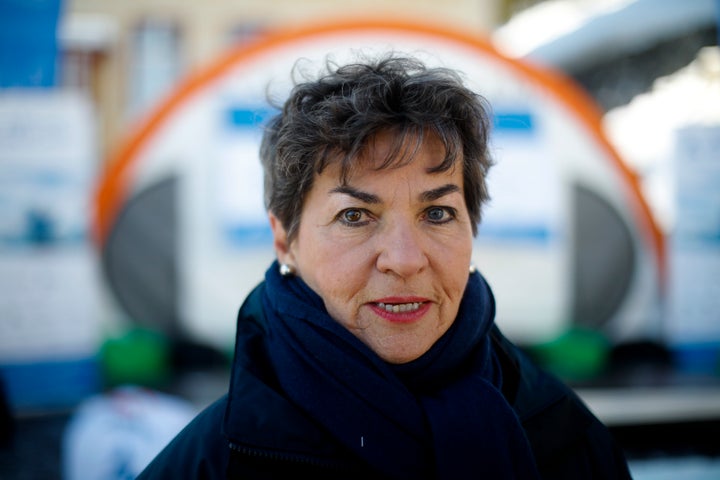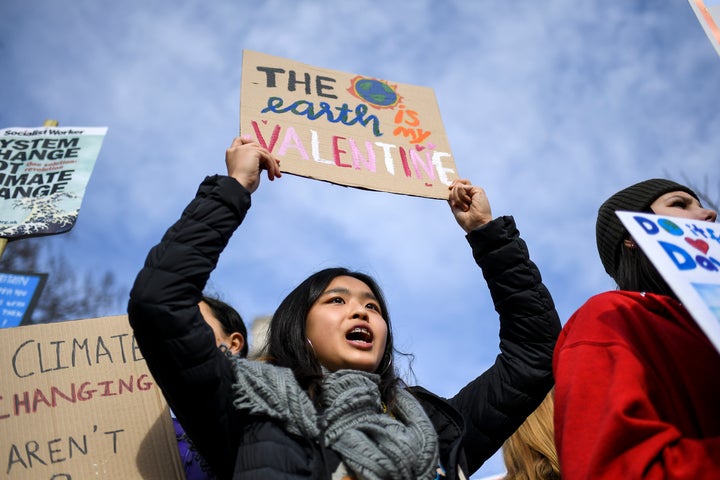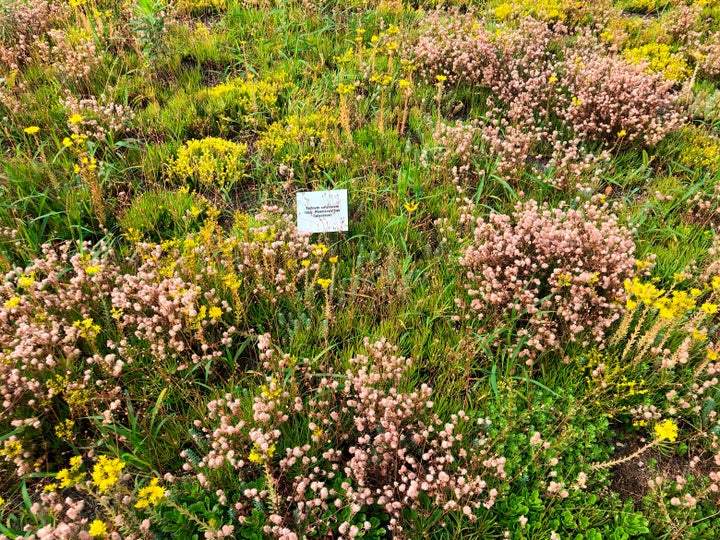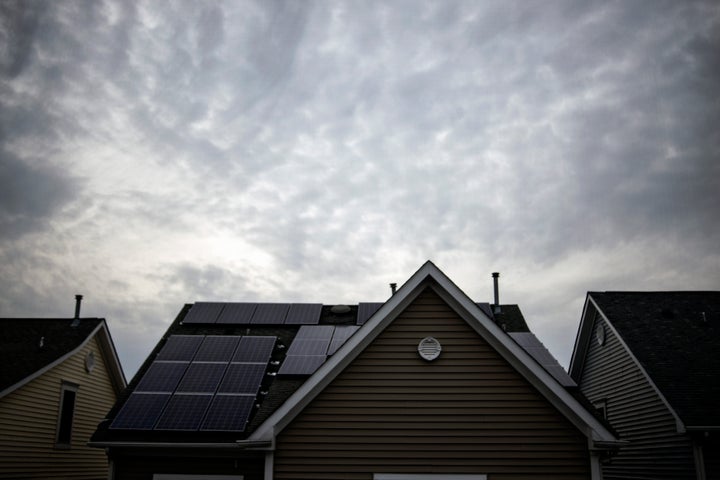The next decade will determine what kind of a world we will create. We can do nothing in the face of a climate crisis that is showing its strength through devastating fires, floods and extreme heat, and usher in a dystopian world of choking pollution and huge swaths of unliveable land.
Or we can act. Everyone, from individuals, to companies, to cities, to countries, works to cut their emissions in half by 2030, steering us away from catastrophe and towards a low-carbon, healthier, happier world.
These are the two worlds Christiana Figueres sets out in her new book “The Future We Choose: Surviving the Climate Crisis,” written with her former senior adviser Tom Rivett-Carnac.
Figueres has every reason to feel despair. As the lead U.N. negotiator for the landmark Paris climate summit in 2015, she pulled off the seemingly impossible. She wrangled with 196 nations to produce a historic climate agreement, with countries agreeing to genuine commitments to slash emissions.

Fast forward to 2020 and the world is a different place. President Donald Trump will pull the U.S. out of the Paris agreement if he gets a second term, the Madrid climate summit in December ended in failure and watered down promises, and most global leaders are refusing to step up to the urgency of the climate crisis.
Yet Figueres remains stubbornly positive. Here she talks to HuffPost about the dire situation we are in, and why she has written an ode to optimism in the face of an existential crisis.
The interview has been edited for length and clarity.
You say this is the most important decade in the history of humanity. What’s at stake?
What’s at stake over the next decade is nothing less than the future of the planet and of humanity on the planet. That’s no exaggeration, that is no hyperbole. That is actually scientific fact.
It is in this decade that we will either reach a concentration of greenhouse gases in the atmosphere that is so dangerous that we will not be able to manage the negative consequences for years to come and the increasingly destructive forces of nature will wreak havoc upon, not just infrastructure and biodiversity, but also on the ability of humans to live on this planet.
Or, the other choice is that we wake up to the fact that during these 10 years we can decisively change the course of those greenhouse gases, we can bring them down to one half of what they are now, and along that journey, we can actually do a lot of good.

We can increase public health, we can increase the quality of urban life, we can increase the comfort and smartness of transportation. And actually, I also think that we can rise as a human species; we can rise to a higher level of consciousness and a higher level of understanding of who we are on this planet.
So it’s a pretty simple choice if you ask me, we just have to make the choice!
In the book you set out a vision of the future in 2050 if we do nothing ― it is a bleak scene of air thick with pollution, contaminated water, searing temperatures. It’s a really scary picture. What role do you think fear plays in climate action?
I put fear into a broad family of sentiments: fear, grief, despair, hopelessness, helplessness. All those sentiments that we usually think of as being negative sentiments, I actually think that they’re very helpful, because what they do is they raise the alarm, they raise the flag that something is wrong. They wake us up and force us to come out of our comfort zone.
The question then is, where do we go from there? If we wake up from that comfort zone and push ourselves on to a meaningful path toward constructing a different world, then we have done the right thing by future generations.

If we realize that we’re in grief, despair and helplessness, and we consciously choose to stay there and we give up, and we say actually this is too much, this is overwhelming and we’re not up to it ― then that will become our reality, it will be a self-fulfilling prophecy.
We stand at the most crucial crossroads, not only in the evolution of the planet, but in the future human experience on this planet, and we need to make a conscious wakeful choice. Because if we don’t, we will be dragged by business-as-usual forces that take us to the first absolutely horrible world.
At its heart, this book is about optimism and you write in the book “optimism is not soft it is gritty.” What did you mean by this?
Optimism has actually become a very controversial term within the climate field. So it’s important to understand what we mean by optimism.
We don’t mean naive ignorance of what the consequences are. We also don’t mean an irresponsible sense that things are going to work out and we don’t have to do anything.
What we mean by optimism is, firstly, a conscious choice to acknowledge, understand and educate ourselves about what the reality is out there and the consequences that we may be facing.
“It is difficult. Anything that is new and different and unknown is always difficult. So we have to be gritty.”
The second part is to make a mindful decision that we are going to change the course of where we’re currently going. It is like we’ve been going down a highway at full speed and all of a sudden we have an exit sign, and we have to decide, are we going to exit or we just going to go down the highway?
We call it a “stubborn” or “gritty” optimism because we have to understand that taking this exit and constructing a completely different trajectory is not going to be easy. It is difficult. Anything that is new and different and unknown is always difficult. So we have to be gritty; we have to be determined; we have to be very focused on what we want to attain and how we’re going to attain it.
There’s absolutely no space for giving up. We have to construct a different future. But the good news is that we can and we have 10 years, and it is amazing what we can do in 10 years if we make the decision now and start right away.
The book talks a lot about individual actions to tackle climate change. Some people balk at putting an emphasis on individual action because they say it ignores companies’ and governments’ responsibility. What is your take on that?
Well, the fact is that these don’t operate in completely unlinked universes. They feed on each other.
I cannot tell you how many CEOs tell me that they are preparing for a low-carbon future for two very clear reasons. They’re recognizing consumer demand [for low-carbon products] is increasing, certainly in industrialized countries, but also in developing countries. And secondly, they want to be able to access young brains and young brains do not want to work for companies that are irresponsible.
The same thing can be said for governments, and the ultimate individual power that we all have, in democracies at least, is voting. When we begin to see that there is a critical mass of people for whom climate change responsibility is a voting issue, governments begin to act accordingly.
The United States is a very interesting case. Four years ago, there was barely any mention about climate change, even among the Democratic candidates. Today, four years later, every single aspirant to be the Democratic nominee has a solid, climate change platform. Why? Because they know that voters in the United States are beginning to get more and more concerned, and they know that they have to be responsible in order to get those votes.
What individuals do trickles up both to corporations, as well as to government.
Often individual actions that make a difference ― quitting flying, quitting meat, not owning a car ― are framed as actions that will lead to a reduced quality of life. What would you say to that?
I would say that is completely wrong. There is much more quality of life to be had from a low carbon economy.
Let’s start with cities. Cities that turn their transport systems, their infrastructure, their built environment, their living spaces to low carbon are actually much more livable because they’re less congested, they’re less polluted, they have more greenery ― all leading to much better breathing conditions. They will be cities that are more energy self-sufficient, more water self-sufficient. It’s just a much much better quality of life.

A world that goes beyond two degrees [warming], to three or four degrees, is a world of increasing health challenges: whether it is pollution that causes asthma, causes all kinds of respiratory diseases, causes a diminishment in IQ because brains can’t develop. Or if it is the rampant increase in dengue and malaria and other diseases that will spread due to warming temperatures.
[If we don’t tackle climate change] we will have hugely escalating health costs. If we avoid all of that, we will have health savings that we can then invest into smarter energy, more green in cities, better food ― we will be able to support the funding of many measures that address climate change.
So, it is not true that a low carbon society is a poor quality society, it is exactly the opposite.
The book talks about the need for a redefinition of our relationship with each other and the world around us, moving away from individualism. How can we achieve this fundamental mind shift over a short period of time?
It is simply a choice, an active choice of starting with small things in our daily lives and being much more mindful of the impact, and making a decision to have a smaller impact on what you buy and how much you buy.
Oh my goodness. Do we really need everything that we buy? When is enough, enough? Do we really need the fourth or fifth or sixth pair of shoes? Or the fourth or fifth or sixth sweater?
We are already getting out of single-use plastics in many countries. That’s a really good start. But we should move away from single-use anything: single-use fashion, single-use appliances, single-use furniture. We should get out of that single-use mentality and understand that a sharing economy, a circular economy, is the only way to go.
And we reach that conclusion as soon as we are much more mindful about our carbon footprint and how we walk upon this earth.
What would be the biggest things you would suggest that we as individuals could do to start tackling that carbon footprint?
Figure out what your carbon footprint is per year, then start to identify what you can do today, tomorrow and the next day to begin to lower that carbon footprint.
Food is a very clear one. If you’re still eating red meat every single day, you do yourselves a favor, you do your body and your health a favor, by starting to diminish red meat. Choose one day where you don’t need red meat, and then a second day, a third day. You can also start to be much more mindful about the foods that you eat, which, in as much as they’re seasonal and local, have a lower carbon footprint.
In your home you can be much more conscious about energy consumption. We don’t tend to think about energy, which is amazing because we do track our finances, and we know where our salary goes and what we spend it on. We should also know what we spend on energy.

Be mindful of the fact that you don’t necessarily have to have all the lights on in every single room in the house when you’re not in that room. Be mindful of the fact that you can insulate your home much better so that in the winter, you can heat your home more efficiently.
You can also choose what quality of energy you use. Move toward more renewable energy, whether you use it from the grid or whether you put solar panels on your roof.
Then of course transport is a big issue. Are we being conscious about the way we transport ourselves, whether by land or by air? There are just so many things that we can do to just cut down on unnecessary transport. And if it is necessary, then share that transport mode, so that the emissions are also shared.
President Trump is trying to withdraw from the Paris agreement, the Madrid climate summit ended in failure, and governments around the world are failing to act. In this context, what is it that gives you the most optimism?
I would actually point to two things. The first is the fact that just a few days ago, we had confirmation that global greenhouse gases, contrary to all expectations that they were going to be increasing in 2019, were flat. And that is very good news.
It doesn’t mean that with that flattening out of emissions that we’ve actually done our job. One year does not a trajectory make, so the question to be answered over the next few years is: Have we started to de-link economic growth from growth in carbon emissions? Because that is what we need to do.
And the second cause for optimism is the fact that financial markets seem to finally have understood that investments in high carbon assets are just hugely risky, and that there is less risk and more reward in shifting capital over to low carbon assets.
You have the asset owner Alliance, which is a group of the largest institutional investors in the world, totaling more than $2 trillion, which has already come out and said we understand that in order to protect the value of our assets we have to move over to a net zero carbon portfolio by 2050.
You also have the letter from Larry Fink, who heads up the largest asset management company in the world, BlackRock, which manages $7 trillion. He says he has understood that high carbon is highly risky. BlackRock will no longer be investing in coal, they will be shifting their investments, and they’re asking all other asset managers to do so.
Finally, what do you want people to take away from this book?
The conclusion that climate change is real, and it is affecting us already, we have 10 years to address it, and I personally can contribute to the solution.
The Future We Choose: Surviving the Climate Crisis by Christiana Figueres and Tom Rivett-Carnac will be published on February 25, 2020 and can be preordered here.
For more content and to be part of the “This New World” community, follow our Facebook page.
HuffPost’s “This New World” series is funded by Partners for a New Economy and the Kendeda Fund. All content is editorially independent, with no influence or input from the foundations. If you have an idea or tip for the editorial series, send an email to thisnewworld@huffpost.com.